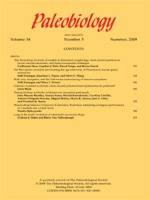Evolutionary stasis has often been explained by stabilizing selection, intrinsic constraints, or, more recently, by spatially patterned population dynamics. To distinguish which of these mechanisms explains a given case of stasis in the fossil record, stasis must first be rigorously documented in a high-resolution stratigraphic time series of fossil specimens. Furthermore, past studies of evolutionary mode in fossil mammalian lineages have often been limited to univariate traits (e.g., molar crown area). It is reasonable to assume that tooth shape, a multivariate trait, reflects important additional aspects of tooth form and function. Here we present the results of a geometric morphometric analysis of the lower dentition of the Paleocene-Eocene condylarth species Ectocion osbornianus collected from the Bighorn and Clarks Fork Basins of northwestern Wyoming. Tooth margin shape, cusp configuration, and shearing crest shape were digitized for the last lower premolar, p4, and for two lower molars, m1 and m3. Multivariate statistical tests of evolutionary mode were used to analyze the change in shape variance over time in addition to the magnitude and direction of shape change. Test results characterize the shape time series as consisting of counteracting changes with less change than expected under a random walk (i.e., stasis). The temporal structure of shape variance implies that the sampled E. osbornianus most likely represent a single population, which is not concordant with the population dynamic mechanism of stasis. Stabilizing selection and/or intrinsic constraints remain as the mechanisms that could explain stasis in the lower dental shape of E. osbornianus despite the variable environmental conditions of the Paleocene–Eocene.
How to translate text using browser tools
1 March 2007
Multivariate stasis in the dental morphology of the Paleocene-Eocene condylarth Ectocion
Aaron R. Wood,
Miriam L. Zelditch,
Adam N. Rountrey,
Thomas P. Eiting,
H. David Sheets,
Philip D. Gingerich
ACCESS THE FULL ARTICLE

Paleobiology
Vol. 33 • No. 2
March 2007
Vol. 33 • No. 2
March 2007




